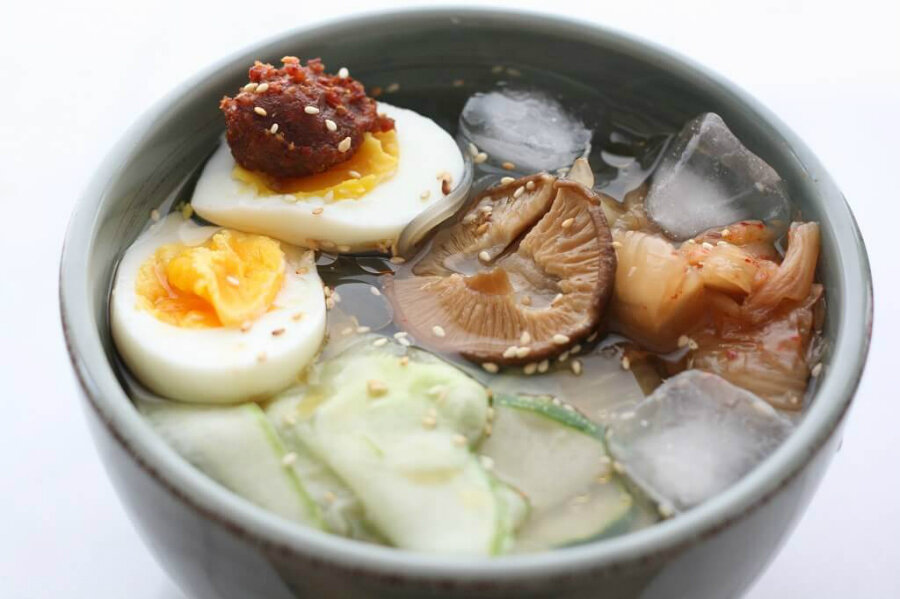Heatwave cooking: buckwheat noodles on ice
Loading...
It’s been sweltering here in the metro D.C. area. In fact, temps surged to 115 degrees F with the heat index several Mondays ago. It’s been so hot and muggy, all I want to do is hole myself up indoors and exert as little energy as possible. Seriously, I break out in a sweat just by walking from the mailbox to my front door!
Sound familiar?
My antidote is an icy-cold bowl of noodles.
Cold noodles are common in many Asian cultures. The Chinese have cold sesame noodles and the Japanese have zaru soba. Both these dishes have long been on my radar, however, the Korean version, naengmyeon (literally “cold noodles”), is new to me. I first discovered naengmyeon at a neighborhood Korean restaurant. It was a fluke really. I could order a bowl of noodles as an add-on to our meal for only $3 and I couldn’t resist a good deal.
I didn’t realize it at the time but I ordered bibim naengmyeon, chewy noodles topped with a spicy dressing made primarily from gochujang. As I was about to dig in, the manager stopped by. “You want vinegar and mustard?”
“Sure?” I said, totally unsure. I reasoned that she must be on to something and I added both to my bowl, first in scant quantities followed by more copious amounts. After a few bites, I concluded it was the right thing to do!
At home, a quick internet search revealed bibim naengmyeon’s blander cousin, mul naengmyeon. In this dish, the noodles are served swimming in a cold, tangy broth – made from beef, chicken or dongchimi, radish kimchi soaked in brine – sometimes floating with ice cubes or transformed into a granita/slushy.
Toppings can include sliced cucumbers, Korean pear, pickled radish, boiled egg and/or or slices of cold boiled beef. If you’re at a restaurant, don’t count on someone offering you vinegar and mustard sauce or oil automatically. Ask for them and add to your bowl according to taste before eating.
Just as there are many varieties of broth, the chewy noodles can be made from any number of ingredients: buckwheat, sweet potato starch, arrowroot, or seaweed to name a few.
Both dishes are popular all year round in Korea but are especially refreshing when it’s hot outside, or on that Indian summer day you’ve been wishing for in late September.
While researching naengmyon, I came across a recipe on Maangchi.com for anchovy broth. Since I had dried anchovies in the pantry (don’t ask), I decided to make some for my naengmyeon. After stinking up the entire house (my husband said it was the stinkiest thing I’ve ever made, I beg to differ), I was the only one who’d eat this dish. Anyway, my point is: not everyone likes anchovies so feel free to use beef stock or even dashi (bonito and kelp broth). But honestly, I thought it was very tasty, so be brave! Here’s my version of mul naengmyeon.
Icy-Cold Buckwheat Noodles (Mul Naengmyeon)
Serves 4
Anchovy Broth:
8 cups of water
4 dried shiitake mushrooms
4x4-inch piece of dried kelp
1/4 cup dried anchovies
One 12-oz package of dried Korean buckwheat noodles
Rice vinegar
Granulated sugar
Fine sea salt
Suggested toppings:
2 Asian pears or Bosc pears, peeled and sliced into thin wedges, and submerged in salt water to prevent browning
4 large hard-cooked eggs, halved
1/2 cup kimchi or pickles
Leftover slices of beef or tofu
Garnish:
Sesame oil
Toasted sesame seeds
Korean red pepper paste (gojuchang)
1. Make the anchovy broth. Place the water, mushrooms, kelp, and anchovies in a 4-quart pot. Bring to a boil over medium-high heat then adjust the heat and let the broth simmer gently for 20 minutes. Strain, cool it down and refrigerate. (Make this ahead).
2. Bring a large pot of water to a rolling boil over high heat. Add the dried noodles to the pot in a circular motion, separating the noodles around the pot. Stir occasionally so they don’t stick. Cook until al dente, 3 to 5 minutes. Don’t overcook them or they’ll be gummy! Drain the noodles into a colander and rinse under cold running water several times to remove excess starch. Drain again until ready to serve.
3. To make one serving of broth, mix together 1-1/2 cups broth, 2 teaspoons vinegar, 2 teaspoons sugar, and 1 teaspoon salt. Stir vigorously until the sugar and salt dissolve. Taste and adjust seasonings as needed to achieve a good balance of sweet, salty and sour. Add 5 to 6 ice cubes.
4. To serve, divide the noodles among 4 large bowls. Pour one serving of broth over each bowl. Arrange the pear, pickles, Korean red pepper paste, and 2 egg halves on top. Drizzle with sesame oil and sprinkle with sesame seeds.
Related post on Pickles and Tea: Easy Kimchi Fried Rice






